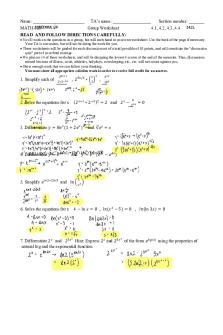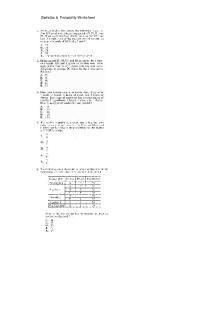TW02 - worksheets PDF

| Title | TW02 - worksheets |
|---|---|
| Course | Experimental Design And Data Analysis |
| Institution | University of Melbourne |
| Pages | 2 |
| File Size | 57.5 KB |
| File Type | |
| Total Downloads | 7 |
| Total Views | 185 |
Summary
worksheets...
Description
EDDA TUTORIAL – Week #2
1. Marijuana and cigarettes. A study of the effects of marijuana recruited young men who used marijuana. Some were randomly assigned to smoke marijuana cigarettes, while others were given placebo cigarettes. What are the flaws of this study? 2. *Lanarkshire Milk experiment (Student, 1931). What are the major issues with this “failed” experiment? It’s not a complete loss though. Could we get something out of it? An experiment was designed to test the effects of raw milk and pasteurized milk on schoolchildren: 5,000 students received raw milk; 5,000 received pasteurized milk and 10,000 no milk. The variable of interest was height and weight gain over five months. The results of the experiment suggested that the students who drank milk exceeded the control group at the end of the experiment by an amount the equivalent of about three months “average growth” in height and four months in weight. Why this dramatic difference? In part, because of the way the treatments were assigned. They followed a two step procedure. First, treatments were randomly assigned. Then, the randomization was “improved” by determining whether there were an undue number of malnourished children in any group, and adjusting accordingly. Presumably, this resulted in a large number of malnourished children being pushed into the “milk” groups, and accordingly biased the estimates of the milk effect. 3. Text questions. Course notes p22: Why should we match cases and controls? Course notes p23: Why does a cohort study give stronger evidence than a case-control study? Course notes p27: Dialogue with a skeptical statistician — discuss. 4. Alcohol and heart attacks. A number of studies indicate that people who drink alcohol in moderation have lower risk of heart attacks than either nondrinkers or heavy drinkers. Does alcohol consumption also improve survival after a heart attack? One study followed 1913 people who were hospitalized after severe heart attacks. In the year before their heart attack, 47% of these people did not drink, 36% drank moderately, and 17% drank heavily. After four years, fewer of the moderate drinkers had died. (a) Is this an experiment or an observational study? (b) Is this a prospective study, retrospective study or a cross-sectional study? (c) What are the response and explanatory variables and what type of variables are they? (d) Discuss possible confounding variables that might impact upon conclusions drawn from the research. (e) How would you present the results? 5. *Genome-wide association studies (GWAS) In a study, researchers collected measurements corresponding to genotypes in 100,000 genetic locations (single nucleotide polymorphisms or SNPs) for genes encoding a candidate genetic region on 67 women affected by breast cancer (Dite et al. (2003), “Familial risks, early-onset breast cancer, 1
and BRCA1 and BRCA2 germline mutations,” Journal of the National Cancer Institute, 95(6), 448–457). Genotypes in each SNP vary from subject to subject and can take 3 values labeled according to nucleotide base pairs (for example, AA, AG, GG). The data for cancer patients were compared to a set of measurements on the same 100,000 SNPs on 266 healthy women from the the Australian Mammographic Density Twins and Sisters Study (Odefrey et al. (2010), “Common genetic variants associated with breast cancer and mammographic density measures that predict disease,” Cancer research, 70(4), 1449–1458). (a) Is this an experiment or an observational study? (b) Is this a prospective study, retrospective study or a cross-sectional study? (c) What are the response and explanatory variables and what type of variables are they? (d) Can researchers use these data to find causes of cancer? 6. Does aspirin reduce risk of heart attack? Can aspirin reduce the risk of heart attack in humans? 22,071 male physicians between the ages of 40 and 84 were randomly assigned to one of two groups. One group took an ordinary aspirin tablet every other day. The other group (control) took a placebo every other day. The rate of heart attacks in the group taking aspirin dropped by 45% compared to the rate in the placebo group. (a) Is this an experiment or an observational study? Discuss the implications for generalising results, assigning causality. (b) Is this a prospective study, retrospective study or a cross-sectional study? (c) What are the response and explanatory variables and what type of variables are they? (d) Discuss possible confounding variables that might impact upon conclusions drawn from the research. (e) Point out a possible known source of confounding that the researchers controlled for in the study. (f) To what population, if any, could the results of this study be generalised? 7. Fisher’s tea tasting experiment. Your tutor claims that they can taste the difference between a cup of tea with milk in which the milk was added after the tea and one where the milk was added before the tea. How would you design an experiment to assess their claim? (a) What is the hypothesis of interest? (b) What treatments should we consider? (c) What are the possible sources of error? (d) How will data be obtained? (e) How will you treat the data after collection (what quantities will you compare)? 8. Problem 1.4 [answer before the tutorial ... any questions?] 9. Problem 1.5 [answer before the tutorial ... any questions?]
2...
Similar Free PDFs

TW02 - worksheets
- 2 Pages

Worksheets
- 6 Pages

Biology Worksheets
- 15 Pages

FRHD resource worksheets
- 8 Pages

Meiosis worksheets (1)
- 8 Pages

ACT math worksheets - cool
- 42 Pages

Amoeba sisters worksheets
- 4 Pages

Math1083Lab Worksheets 132
- 5 Pages

Worksheets-fruit fruit work
- 2 Pages

OA1 grammar worksheets final
- 17 Pages

Week 2 Tutorial worksheets
- 3 Pages

Cell Transport Review Worksheets
- 8 Pages

Free Worksheets 6th Grade
- 15 Pages
Popular Institutions
- Tinajero National High School - Annex
- Politeknik Caltex Riau
- Yokohama City University
- SGT University
- University of Al-Qadisiyah
- Divine Word College of Vigan
- Techniek College Rotterdam
- Universidade de Santiago
- Universiti Teknologi MARA Cawangan Johor Kampus Pasir Gudang
- Poltekkes Kemenkes Yogyakarta
- Baguio City National High School
- Colegio san marcos
- preparatoria uno
- Centro de Bachillerato Tecnológico Industrial y de Servicios No. 107
- Dalian Maritime University
- Quang Trung Secondary School
- Colegio Tecnológico en Informática
- Corporación Regional de Educación Superior
- Grupo CEDVA
- Dar Al Uloom University
- Centro de Estudios Preuniversitarios de la Universidad Nacional de Ingeniería
- 上智大学
- Aakash International School, Nuna Majara
- San Felipe Neri Catholic School
- Kang Chiao International School - New Taipei City
- Misamis Occidental National High School
- Institución Educativa Escuela Normal Juan Ladrilleros
- Kolehiyo ng Pantukan
- Batanes State College
- Instituto Continental
- Sekolah Menengah Kejuruan Kesehatan Kaltara (Tarakan)
- Colegio de La Inmaculada Concepcion - Cebu


